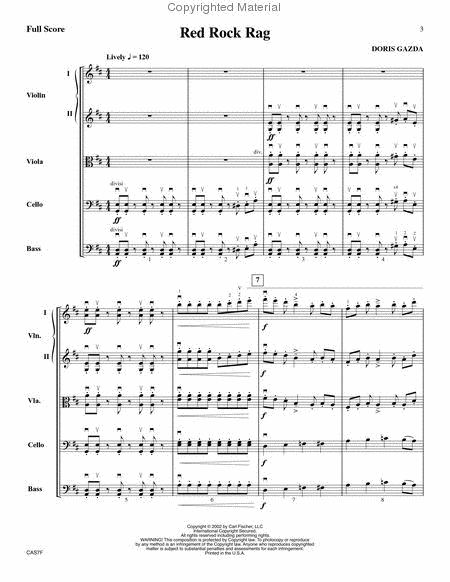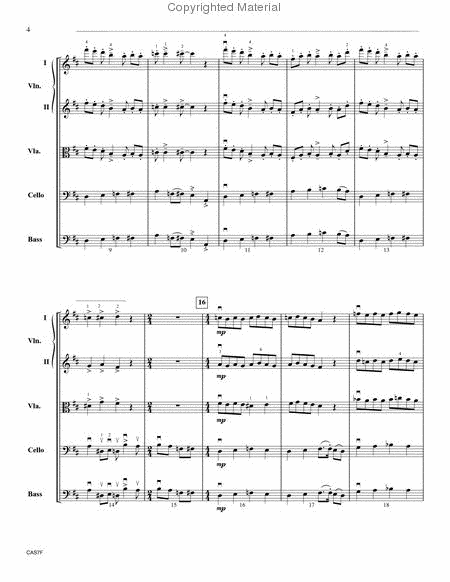Red Rock Rag
-
Ships in 1 to 2 weeks
Details
Description
SKU: CF.CAS7
Composed by Doris Gazda. Edited by Amy Rosen. FS-SWs. Carl Fischer Concert String Orchestra Series. Score and Parts. With Standard notation. 20+24+24+6+15+15+15 pages. Carl Fischer Music #CAS7. Published by Carl Fischer Music (CF.CAS7).ISBN 9780825847578. UPC: 798408047573. 8.5 X 11 inches. Key: D major.
When you have the good fortune to visit Red Rock country in the southwestern United States, you will all at once feel that majesty and beauty in the towering red landscape. You can trek, bike, paddle, ride horseback or drive through the canyons, past the strangely shaped rocks and over the enormous boulders. Each time you turn a corner you will be dazzled by yet another magnificent vista. The Red Rock areas in Utah, Nevada, Arizona and New Mexico formed millions of years ago when that part of North America was primarily under water. The water left behind the shells and skeletons of sea creatures that gradually turned into limestone and similar rocks. Beginning 225 million years ago, the earth's crust began to move and the seabed slowly rose. Streams entering the shallow water deposited mud and sand that turned into shale and marine sandstone. As the land continued to rise and dry out, some of the rocks oxidized (combined with oxygen) and turned red in color. Subsequently the area was covered with sands that eventually compressed into what is called Aztec sandstone. Sometimes, when iron was concentrated in the rock, the sandstone turned a bright red color. Following the introduction, the music in Red Rock Rag takes on a typical ragtime melody and rhythm. It then transitions by changing key, time signature and the structure into a swing waltz. At m. 60, it moves into a combined time signature of one measure of 3/4 time and two measures of 2/4 time with an occasional lick in the bass line. Finally, it moves back into the swing-waltz style and finishes with the original ragtime melody. Red Rock Rag is challenging stylistically and rhythmically. It would be appropriate to study both the ragtime and swing styles while working on it.
When you have the good fortune to visit Red Rock country in the southwestern United States, you will all at once feel that majesty and beauty in the towering red landscape. You can trek, bike, paddle, ride horseback or drive through the canyons, past the strangely shaped rocks and over the enormous boulders. Each time you turn a corner you will be dazzled by yet another magnificent vista. The Red Rock areas in Utah, Nevada, Arizona and New Mexico formed millions of years ago when that part of North America was primarily under water. The water left behind the shells and skeletons of sea creatures that gradually turned into limestone and similar rocks. Beginning 225 million years ago, the earth's crust began to move and the seabed slowly rose. Streams entering the shallow water deposited mud and sand that turned into shale and marine sandstone. As the land continued to rise and dry out, some of the rocks oxidized (combined with oxygen) and turned red in color. Subsequently the area was covered with sands that eventually compressed into what is called Aztec sandstone. Sometimes, when iron was concentrated in the rock, the sandstone turned a bright red color. Following the introduction, the music in Red Rock Rag takes on a typical ragtime melody and rhythm. It then transitions by changing key, time signature and the structure into a swing waltz. At m. 60, it moves into a combined time signature of one measure of 3/4 time and two measures of 2/4 time with an occasional lick in the bass line. Finally, it moves back into the swing-waltz style and finishes with the original ragtime melody.A Red Rock RagA is challenging stylistically and rhythmically. It would be appropriate to study both the ragtime and swing styles while working on it.
When you have the good fortune to visit Red Rock country in the southwestern United States, you will all at once feel that majesty and beauty in the towering red landscape. You can trek, bike, paddle, ride horseback or drive through the canyons, past the strangely shaped rocks and over the enormous boulders. Each time you turn a corner you will be dazzled by yet another magnificent vista. The Red Rock areas in Utah, Nevada, Arizona and New Mexico formed millions of years ago when that part of North America was primarily under water. The water left behind the shells and skeletons of sea creatures that gradually turned into limestone and similar rocks. Beginning 225 million years ago, the earth's crust began to move and the seabed slowly rose. Streams entering the shallow water deposited mud and sand that turned into shale and marine sandstone. As the land continued to rise and dry out, some of the rocks oxidized (combined with oxygen) and turned red in color. Subsequently the area was covered with sands that eventually compressed into what is called Aztec sandstone. Sometimes, when iron was concentrated in the rock, the sandstone turned a bright red color. Following the introduction, the music in Red Rock Rag takes on a typical ragtime melody and rhythm. It then transitions by changing key, time signature and the structure into a swing waltz. At m. 60, it moves into a combined time signature of one measure of 3/4 time and two measures of 2/4 time with an occasional "lick" in the bass line. Finally, it moves back into the swing-waltz style and finishes with the original ragtime melody.A Red Rock RagA is challenging stylistically and rhythmically. It would be appropriate to study both the ragtime and swing styles while working on it.
When you have the good fortune to visit Red Rock country in the southwestern United States, you will all at once feel that majesty and beauty in the towering red landscape. You can trek, bike, paddle, ride horseback or drive through the canyons, past the strangely shaped rocks and over the enormous boulders. Each time you turn a corner you will be dazzled by yet another magnificent vista. The Red Rock areas in Utah, Nevada, Arizona and New Mexico formed millions of years ago when that part of North America was primarily under water. The water left behind the shells and skeletons of sea creatures that gradually turned into limestone and similar rocks. Beginning 225 million years ago, the earth's crust began to move and the seabed slowly rose. Streams entering the shallow water deposited mud and sand that turned into shale and marine sandstone. As the land continued to rise and dry out, some of the rocks oxidized (combined with oxygen) and turned red in color. Subsequently the area was covered with sands that eventually compressed into what is called Aztec sandstone. Sometimes, when iron was concentrated in the rock, the sandstone turned a bright red color. Following the introduction, the music in Red Rock Rag takes on a typical ragtime melody and rhythm. It then transitions by changing key, time signature and the structure into a swing waltz. At m. 60, it moves into a combined time signature of one measure of 3/4 time and two measures of 2/4 time with an occasional "lick" in the bass line. Finally, it moves back into the swing-waltz style and finishes with the original ragtime melody. Red Rock Rag is challenging stylistically and rhythmically. It would be appropriate to study both the ragtime and swing styles while working on it.
When you have the good fortune to visit Red Rock country in the southwestern United States, you will all at once feel that majesty and beauty in the towering red landscape. You can trek, bike, paddle, ride horseback or drive through the canyons, past the strangely shaped rocks and over the enormous boulders. Each time you turn a corner you will be dazzled by yet another magnificent vista. The Red Rock areas in Utah, Nevada, Arizona and New Mexico formed millions of years ago when that part of North America was primarily under water. The water left behind the shells and skeletons of sea creatures that gradually turned into limestone and similar rocks. Beginning 225 million years ago, the earth's crust began to move and the seabed slowly rose. Streams entering the shallow water deposited mud and sand that turned into shale and marine sandstone. As the land continued to rise and dry out, some of the rocks oxidized (combined with oxygen) and turned red in color. Subsequently the area was covered with sands that eventually compressed into what is called Aztec sandstone. Sometimes, when iron was concentrated in the rock, the sandstone turned a bright red color. Following the introduction, the music in Red Rock Rag takes on a typical ragtime melody and rhythm. It then transitions by changing key, time signature and the structure into a swing waltz. At m. 60, it moves into a combined time signature of one measure of 3/4 time and two measures of 2/4 time with an occasional "lick" in the bass line. Finally, it moves back into the swing-waltz style and finishes with the original ragtime melody. Red Rock Rag is challenging stylistically and rhythmically. It would be appropriate to study both the ragtime and swing styles while working on it.
When you have the good fortune to visit Red Rock country in the southwestern United States, you will all at once feel that majesty and beauty in the towering red landscape. You can trek, bike, paddle, ride horseback or drive through the canyons, past the strangely shaped rocks and over the enormous boulders. Each time you turn a corner you will be dazzled by yet another magnificent vista.The Red Rock areas in Utah, Nevada, Arizona and New Mexico formed millions of years ago when that part of North America was primarily under water. The water left behind the shells and skeletons of sea creatures that gradually turned into limestone and similar rocks. Beginning 225 million years ago, the earth's crust began to move and the seabed slowly rose. Streams entering the shallow water deposited mud and sand that turned into shale and marine sandstone. As the land continued to rise and dry out, some of the rocks oxidized (combined with oxygen) and turned red in color. Subsequently the area was covered with sands that eventually compressed into what is called Aztec sandstone. Sometimes, when iron was concentrated in the rock, the sandstone turned a bright red color.Following the introduction, the music in Red Rock Rag takes on a typical ragtime melody and rhythm. It then transitions by changing key, time signature and the structure into a swing waltz. At m. 60, it moves into a combined time signature of one measure of 3/4 time and two measures of 2/4 time with an occasional "lick" in the bass line. Finally, it moves back into the swing-waltz style and finishes with the original ragtime melody. Red Rock Rag is challenging stylistically and rhythmically. It would be appropriate to study both the ragtime and swing styles while working on it.



 Share
Share